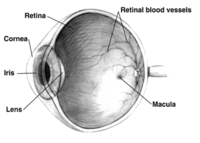
Photo from wikipedia
Different damage factors are known to trigger cell death in the optic nerves. Use of mesenchymal stem cells is a possible treatments option for traumatic optic nerve injury due to… Click to show full abstract
Different damage factors are known to trigger cell death in the optic nerves. Use of mesenchymal stem cells is a possible treatments option for traumatic optic nerve injury due to their ability to secrete protective cytokines and recovery factors. In this study, we investigated the neuroprotective effects of human placenta‐derived mesenchymal stem cells (hPMSCs) using an established optic nerve compression model and model of R28 cells that were exposed to hypoxia. Forty percent of axon death was seen in induced in vivo optic nerve injury model (p < .05), and 70% of R28 cells exposed to cobalt chloride (CoCl2), leading to hypoxia, underwent apoptosis (p < .05). After intravenous injection of hPMSCs into tail vein, there was 25% improvement of axon survival in vivo (p < .05). R28 cells incubated with hPMSCs after exposure to hypoxic condition resulted in 50% increased cell survival compared with R28 cells without hPMSC exposure (p < .05), suggesting the active release of multiple factors related to cell survival. In addition, we found that Nf‐κb protein mediates neuroprotection pathway via up‐regulation of target proteins regulated by hPMSCs. Therefore, we assert that Nf‐κb was one of the mediator proteins in a recovery pathway induced by hPMSCs. In conclusion, these indicate that transactivation of Nf‐κb protein has a critical role in recovery mechanism by hPMSCs. We suggest that hPMSCs have abilities to recover neuronal damages by up‐regulating the expression of genes associated with axon survival and can a better understanding of the possible role of hPMSCs in the treatment modalities of optic nerve injury.
Journal Title: Journal of Tissue Engineering and Regenerative Medicine
Year Published: 2018
Link to full text (if available)
Share on Social Media: Sign Up to like & get
recommendations!